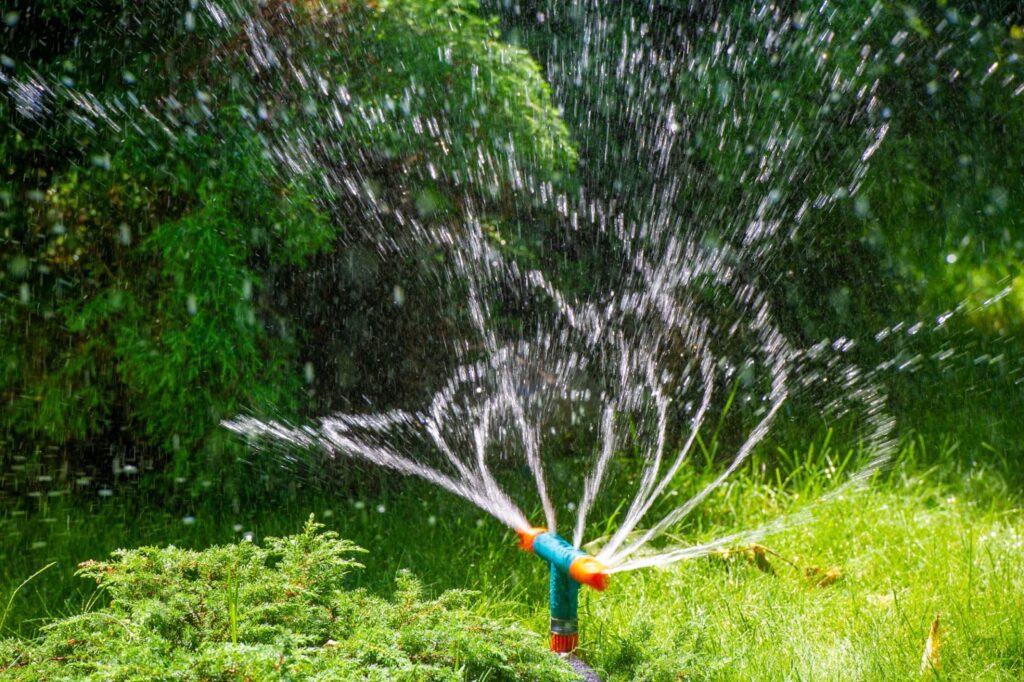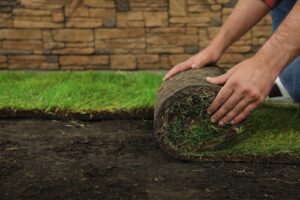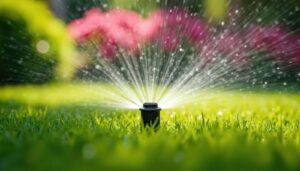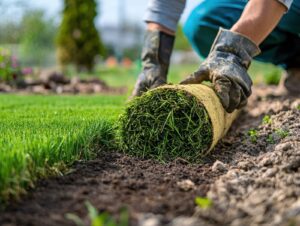Are you dreaming of a sustainable lawn that’s lush, green, and environmentally friendly? You’re not alone. Many homeowners wish to combine the beauty of a well-maintained yard with practices that support the planet.
Sustainable lawn care is gaining momentum as people realize they can have beautiful landscapes without compromising the health of their local ecosystems. Maintaining a lawn sustainably involves more than just cutting the grass regularly. It’s about choosing the right methods that benefit the soil, conserve water, and reduce chemical use.
This approach not only enhances the appearance of your yard but also ensures it thrives in harmony with nature. With a few smart choices and simple lawn care routine changes, you help protect biodiversity and promote a healthier environment in your backyard.
Let’s take a look at how you may transform your lawn care practices. This guide will outline multiple ways to maintain your lawn sustainably, from selecting the best type of grass for your climate to embracing natural weed control methods.
Each strategy aims to minimize environmental impact while maximizing the health and beauty of your lawn. Get ready to see how easy and rewarding eco-friendly lawn maintenance can be!
1 – Choose the right type of grass
The first step towards a sustainable lawn is choosing the right type of grass. Different grass species thrive in different climates and soil types. Selecting a variety that naturally excels in your local conditions minimizes the need for water, fertilizers, and pesticides.
For instance, Bermuda grass is excellent for hot climates due to its drought resistance, while fescue works better in cooler areas.
Researching native grasses could lead to even better sustainability as they are adapted to local conditions and often require less upkeep. Another benefit is that native grasses help support local wildlife, providing habitat and food sources.
2 – Mow properly
Proper mowing is crucial for maintaining a sustainable lawn. Keeping your grass at the optimal height will encourage root development and decrease the need for watering. Keeping mower blades sharp is important to ensure clean cuts, as torn grass leads to disease and pest issues.
Also, vary your mowing pattern to prevent soil compaction and promote uniform growth.
Avoid mowing when the grass is wet to reduce the spread of diseases. Consider mowing in the late afternoon to reduce the stress; midday heat heightens the grass.
3 – Practice natural weed control
Chemical herbicides are harmful to the environment and pose health risks to humans and pets. Instead, manage weeds through natural methods like hand-pulling, using ground covers such as clover, or applying corn gluten meal, a natural pre-emergent weed suppressor.
Introducing beneficial insects that target and control weed growth is able to be an effective biological approach. Also, maintaining healthy soil helps prevent weeds by creating an environment where preferred grass species outcompete the weeds.
4 – Water wisely
Overwatering is a common mistake that leads to shallow root systems, making your lawn more vulnerable to drought and disease. Water your grass deeply but infrequently to encourage deeper root growth. The best time to water is early in the morning, which helps prevent evaporation and fungal growth.
The best time to water is early in the morning, which helps prevent evaporation and fungal growth. Employing rain sensors on irrigation systems prevents watering before and after rainfall, saving water and reducing unnecessary water usage.
Additionally, drip irrigation or soaker hoses directly target the water to the roots, reducing waste and minimizing runoff.
5 – Use organic fertilizers
Organic fertilizers release nutrients slowly, improving soil health over time. Unlike synthetic fertilizers, they provide essential nutrients without the risk of chemical runoff. Organic options like compost or processed manure feed the lawn, improve soil structure, and promote beneficial microbial activity.
Adding green sand or bone meal offers specific minerals like potassium and phosphorus, enhancing growth and root strength. These organic materials also support a more sustainable gardening ecosystem by recycling natural waste into valuable resources.
6 – Embrace mulching
After mowing, leave grass clippings on the lawn to act as a natural mulch. They decompose and return valuable nutrients to the soil, reducing the need for additional fertilizers. Mulching also helps retain moisture, reducing water usage.
For an even more effective mulching approach, consider adding layers of leaf mulch in the fall to provide insulation and further nutrient-rich decomposition. This strategy conserves water and reduces the need for weed control, as it helps suppress weed germination and growth.
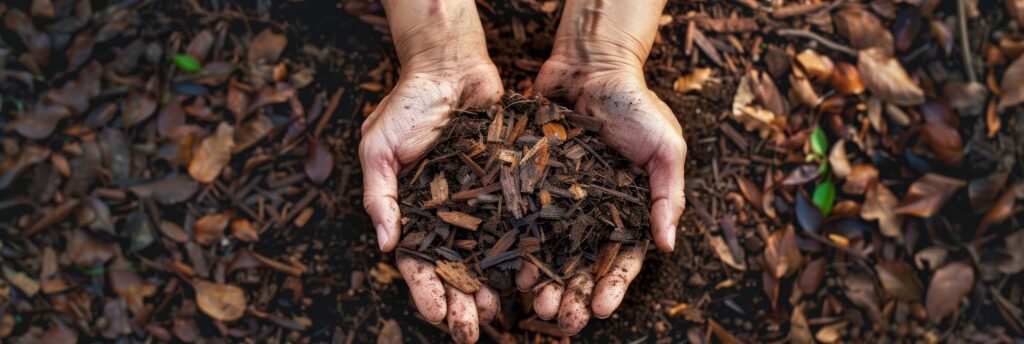
7 – Encourage biodiversity
A biodiverse lawn, where various plants coexist, is healthier and more resilient. Consider integrating native plants or wildflowers into your lawn to attract beneficial insects and improve biodiversity. These plants often require less maintenance and are better suited to local climate conditions.
Adding diverse plant species also reduces the prevalence of pests and diseases, as these are harder to spread in a varied environment. Additionally, fostering a variety of grasses and plants enhances the visual appeal of your lawn, creating a vibrant and dynamic landscape.
8 – Implement integrated pest management (IPM)
Instead of relying on pesticides, use integrated pest management techniques to control pests sustainably. IPM encourages natural pest control methods, such as attracting predatory insects that feed on common pests and practicing crop rotation, even in a small garden.
Introducing barriers or traps may also be an effective non-chemical approach to managing pests. Establishing a habitat for birds also aids in pest control, as many bird species are natural predators of lawn and garden pests. These techniques maintain the ecological balance and reduce the dependency on harmful chemicals.
9 – Aerating and dethatching
Soil compaction restricts water, oxygen, and nutrient flow. Aerating your lawn by making holes in the soil helps alleviate compaction and improves root penetration. Similarly, removing thatch build-up with a rake or dethatcher allows your lawn to breathe and absorb nutrients more effectively.
Performing these tasks during the early spring or fall optimizes grass recovery and growth conditions. Make sure to aerate when the soil is moist enough for the aeration tools to penetrate effectively, but not so wet that it sticks to the tools.
10 – Monitor and adjust
Regularly monitor your lawn’s health and adjust your maintenance practices accordingly. Pay attention to signs of stress, such as discoloration or patchiness, and adjust your watering or fertilization schedule as needed.
Keeping a close eye on your lawn allows you to catch potential problems early and address them without resorting to harsh chemicals.
Use a soil test kit annually to check nutrient levels and pH balance, enabling precise adjustments to your lawn care regimen. Additionally, observe the impact of changing weather patterns on your lawn and adapt your care techniques to meet these new challenges effectively.
11 – Educate yourself and others
Staying informed about sustainable lawn care practices is crucial. Take advantage of local resources like university extension programs or gardening clubs that offer workshops and guides on eco-friendly lawn maintenance.
Sharing knowledge with neighbors and friends can also help spread sustainable practices throughout your community.

12 – Use solar-powered lawn equipment
Reduce your carbon footprint by switching to solar-powered lawn equipment. Solar mowers, trimmers, and blowers are becoming more available, providing a greener alternative to gasoline-powered equipment. They not only reduce emissions but also save on fuel costs.
As you embrace these sustainable practices, you’ll notice not only how your lawn becomes healthier, but also how your local environment starts to flourish. It’s a rewarding experience to see birds, bees, and butterflies return to a space that supports their survival.
Sustainable lawn care does more than improve the aesthetics of your home; it creates a sanctuary for wildlife and a safe space for your family and pets to enjoy.
Remember, every small step toward sustainable lawn care makes a big difference.
You become a part of a larger movement toward environmental stewardship, contributing to global efforts to combat pollution and conserve resources. Your lawn can serve as a prime example in your community, inspiring neighbors and friends to adopt eco-friendly practices in their yards.
So, pick up your gardening tools with pride and know you are doing something great for the planet. Adjust your lawn care routine gradually, introducing more sustainable practices as you go.
You’ll find that maintaining a green, vibrant lawn sustainably is not only possible but also incredibly fulfilling. Let’s all do our part, one lawn at a time, to make a lasting impact on the world around us.
Achieve the finest sod in Utah with Monarch Sod
For the highest quality sod in Utah, look no further than Monarch Sod. Their dedication to top-notch sod and expert guidance is your gateway to a lush, thriving lawn. Dealing with Utah’s diverse climate or complex soil needs? Monarch Sod stands as your reliable ally.
As you pursue the creation of your ideal lawn, remember you have support every step of the way. From choosing the right sod to ongoing care, Monarch Sod is there to help you cultivate a durable and beautiful landscape.
Contact Monarch Sod today at 801-701-8633 and see the change — a call today brings you closer to your perfect lawn.
daftar situs gacor situs slot situs toto situs toto monperatoto kampungbet keluaran hk slot gacor kampungbet data macau rtp slot situs toto kampungbet situs hk bento4d slot terpercaya toto slot toto slot toto slot toto slot toto slot link slot gacor situs slot gacor situs toto toto slot toto togel bento4d toto slot situs toto situs togel bento4d login toto slot situs gacor








